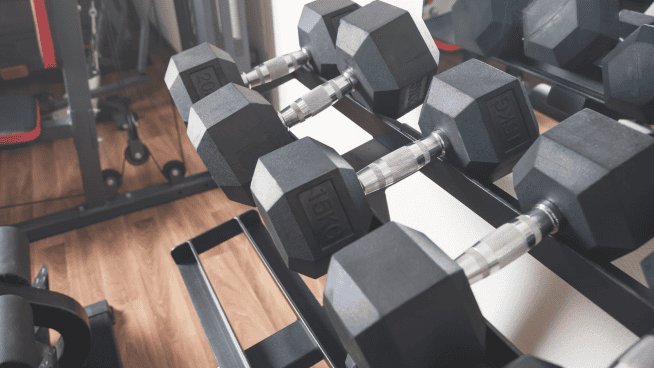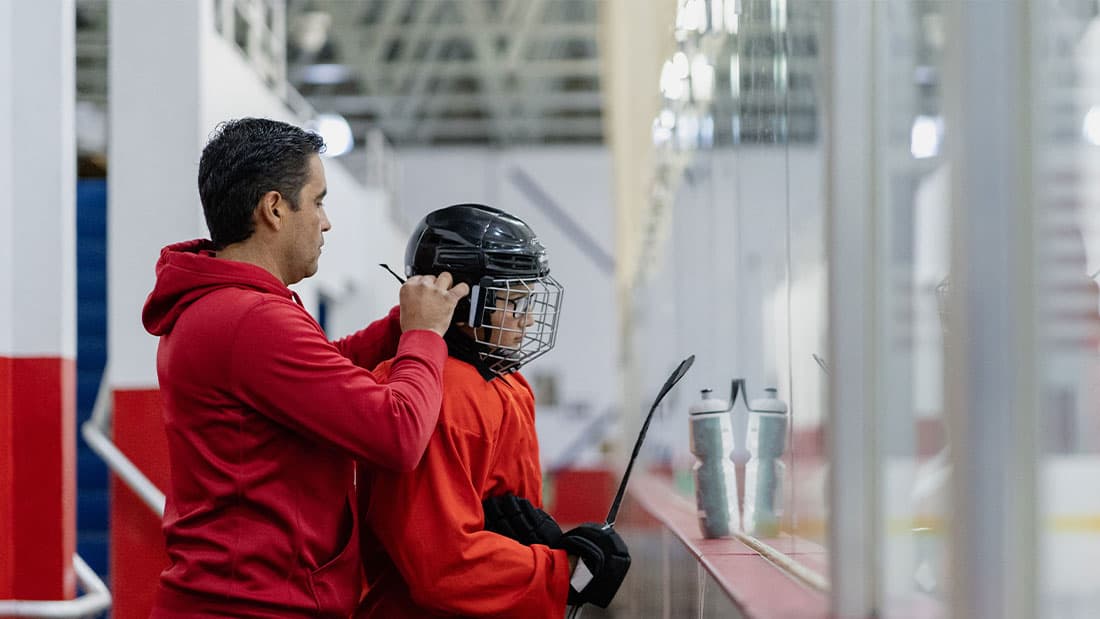How French Contrast Training can Boost and Ignite Your Training and Performance
French Contrast Training (FCT) is an advanced training method designed to take your strength, speed, and power to the next level. It strategically combines heavy strength training exercises with plyometrics, leveraging a scientific principle known as post-activation potentiation (PAP) to maximize your performance gains.
PAP is the temporary boost in muscular force production immediately following a maximal or sub-maximal effort.
By strategically placing a plyometric exercise after a heavy lift at 80-90% or 50-60% one rep max, FCT capitalizes on this heightened state of neuromuscular activation.
This allows you to generate more explosive power and force than you could typically do polymetrically.
Youth Athletes
- FCT can develop the neural response for young athletes looking to develop foundational strength, power, and coordination.
Athletes in Power-Dominant Sports
- Sprinters can use FCT to improve explosive speed and acceleration.
- Jumpers can enhance their vertical leap and reactive strength.
- Throwers can increase power in activities such as shot put, discus, and javelin.
Team Sport Athletes
- Soccer Players: For better sprinting speed, agility, and jumping ability.
- Basketball Players: To improve vertical jump for rebounding, dunking, and lateral quickness.
- American Football Players: For enhanced explosive strength and power, crucial for tackles, sprints, and jumps. A High School Football Player**: Incorporating French contrast training to improve sprint speed, tackle strength, and overall power on the field.
- Rugby Players: To develop overall power, speed, and strength, which are useful in scrums, tackles, and sprints.
Combat Sport Athletes
- Boxers: To increase punching power and speed.
- MMA Fighters: For improved explosive power in strikes, takedowns, and grappling.
Track and Field Athletes
- Hurdlers: To develop power and speed for quick clearance of hurdles.
- Pole Vaulters: For enhanced explosive strength and agility.
General Fitness Enthusiasts
- Strength and Conditioning Enthusiasts: Those looking to break through training plateaus and add variety to their workouts.
- CrossFit Athletes: To improve overall power and performance in high-intensity workouts.
Rehabilitation and Return-to-Sport
- Injured Athletes: Once cleared for high-intensity training, this method can help them regain lost power and strength more effectively.
French contrast training is particularly beneficial for athletes and individuals seeking to improve their strength, power, and overall athletic performance.
Here are several reasons why you might incorporate this training method into your regimen:
Maximize Power Development
Post-Activation Potentiation (PAP): By performing heavy lifts followed by explosive movements, you can take advantage of PAP, which enhances muscle performance and power output. This can lead to significant improvements in explosive strength, which is crucial for sports like sprinting, jumping, and throwing.
Efficient Use of Training Time
Combined Training Stimuli: French contrast training efficiently combines strength, speed, and power exercises in one session, reducing the need for separate workouts for each attribute. This can be particularly useful for athletes with limited time to train.
Improved Athletic Performance
Transfer to Sport-Specific Skills: The combination of heavy lifting and plyometrics closely mimics the demands of many sports. This method can improve performance in activities requiring rapid force production, such as sprinting, jumping, and changing direction.
Enhanced Neuromuscular Adaptation
Increased Muscle Fiber Recruitment: The varied exercises within a single set help recruit more muscle fibers and improve neuromuscular coordination. This can lead to greater power, speed, and strength gains than traditional training methods.
Plateau Busting
Breaking Training Plateaus: If you’ve hit a plateau in your training, French contrast training can provide a new stimulus to help you overcome stagnation. Combining different exercise types challenges your muscles and nervous system in new ways, promoting further adaptation and growth.
Versatility and Adaptability
Customizable for Different Goals: This training method can be adapted for various fitness goals. Whether focusing on increasing maximum strength, enhancing explosive power, or improving athletic performance, FCT can be tailored to meet your needs.
Engaging and Challenging Workouts
Variety and Intensity: The diversity of exercises and the high-intensity nature of French contrast training can make workouts more engaging and mentally stimulating. This can help maintain motivation and adherence to your training program.
Example Application
Imagine you’re a soccer player looking to improve your sprinting, speed, and jumping ability:
1. Heavy Compound Movement: Weighted Back Squat – 2 reps at 85% of 1RM to build maximum strength.
2. Plyometric Movement: Box Jumps – 5 reps to enhance explosive power.
3. Speed-Strength Movement: Speed Squats – 3 reps at 40% of 1RM to improve speed and muscle fiber recruitment.
4. Reactive Plyometric Movement: Hurdle Hops – 5 reps to develop reactive strength and agility.
For sprinting:
- Heavy sled pulls (85%) for 5 seconds.
- Sprint 30 meters.
- Sled Pulls (50%) for 5 seconds.
- Bounders for 20m or sprint 30m.
By consistently incorporating this type of training into your routine, you will see improvements in your ability to sprint faster and jump higher, benefiting your performance on the field.
French contrast training is a method used to enhance athletic performance, particularly strength and power. This training technique combines different types of exercises within a single workout to maximize muscle activation and adaptation. It typically involves a combination of heavy strength exercises, plyometrics, and speed-strength movements.
Structure of French Contrast Training
A typical French contrast training set consists of the following sequence:
Heavy Compound Movement: A high-load strength exercise, such as a squat or bench press, typically performed with 50-90% of the one-rep max (1RM) for 1-3 reps. This activates the nervous system and recruits a large number of muscle fibers. The reps are not until max. So, only do 2 to 3 reps if it is a five-rep max. The key is to supercharge the muscles, not fatigue them.
Many people make the mistake of doing max reps, which is why they lose PAP, and FCT does not work well for them. Stimulation is the key to the circuit. Not annihilate and fatigue.
Plyometric Movement: An explosive movement, such as a jump or medicine ball throw, is done immediately after the heavy compound movement to take advantage of the post-activation potentiation (PAP) effect. This exercise is typically performed for 3-5 reps.
Speed-Strength Movement: A lighter load movement performed at high speed, such as a speed squat or bench press with 30-50% of the 1RM, for 3-5 reps.
Reactive Plyometric Movement: A low-resistance, high-velocity movement, such as hurdle jumps, sprinting, or bounding, performed for 3-5 reps to enhance explosive power.
Benefits of French Contrast Training
1. Enhanced Power and Explosiveness: By combining heavy strength exercises with plyometrics and speed-strength movements, French contrast training maximizes the development of power and explosiveness.
2. Increased Strength: The heavy compound movements contribute to strength gains by stimulating the nervous system and increasing muscle fiber recruitment.
3. Improved Neuromuscular Efficiency: The variation in exercise types within a single set improves the efficiency of the neuromuscular system, leading to better coordination and muscle activation.
4. Time Efficiency: This training method targets multiple aspects of athletic performance within a shorter timeframe.
5. Greater Muscle Activation: The use of post-activation potentiation (PAP) increases muscle activation and can lead to more significant overall gains in strength and power.
6. Enhanced Athletic Performance: Athletes can benefit from improved speed, strength, and explosive power, making this method particularly useful for sports requiring these attributes.
Example of a French Contrast Training Set
For an athlete focusing on lower body strength and power:
1. Heavy Compound Movement: Back Squat – 2 reps at 85% of 1RM
2. Plyometric Movement: Vertical Jump – 5 reps
3. Speed-Strength Movement: Dumbbell Speed Squats – 3 reps at 40% of 1RM
4. Reactive Plyometric Movement: Box Jumps or Vertical Jumps – 5 reps
Rest 15 -20 seconds in-between exercises and 3 minutes at the end, and do 3-5 sets.
This sequence is repeated for multiple sets, usually with adequate rest between sets to ensure quality and intensity are maintained throughout the workout.
The French Contrast Training was developed to enhance power endurance and explosive speed. FCT is demanding and challenging, so if your nerves and muscles are not accustomed to facilitating PAP (post-activation potentiation), you may not achieve optimal results or perform the exercise correctly.
To see more routines, exercises, and programs for FCT, complex, and contrast training, check out my book, Instant Strength. And check out my YouTube channel for more methods and techniques, Balanced Body.
RECOMMENDED FOR YOU
MOST POPULAR
How French Contrast Training can Boost and Ignite Your Training and Performance
French Contrast Training (FCT) is an advanced training method designed to take your strength, speed, and power to the next level. It strategically combines heavy strength training exercises with plyometrics, leveraging a scientific principle known as post-activation potentiation (PAP) to maximize your performance gains.
PAP is the temporary boost in muscular force production immediately following a maximal or sub-maximal effort.
By strategically placing a plyometric exercise after a heavy lift at 80-90% or 50-60% one rep max, FCT capitalizes on this heightened state of neuromuscular activation.
This allows you to generate more explosive power and force than you could typically do polymetrically.
Youth Athletes
- FCT can develop the neural response for young athletes looking to develop foundational strength, power, and coordination.
Athletes in Power-Dominant Sports
- Sprinters can use FCT to improve explosive speed and acceleration.
- Jumpers can enhance their vertical leap and reactive strength.
- Throwers can increase power in activities such as shot put, discus, and javelin.
Team Sport Athletes
- Soccer Players: For better sprinting speed, agility, and jumping ability.
- Basketball Players: To improve vertical jump for rebounding, dunking, and lateral quickness.
- American Football Players: For enhanced explosive strength and power, crucial for tackles, sprints, and jumps. A High School Football Player**: Incorporating French contrast training to improve sprint speed, tackle strength, and overall power on the field.
- Rugby Players: To develop overall power, speed, and strength, which are useful in scrums, tackles, and sprints.
Combat Sport Athletes
- Boxers: To increase punching power and speed.
- MMA Fighters: For improved explosive power in strikes, takedowns, and grappling.
Track and Field Athletes
- Hurdlers: To develop power and speed for quick clearance of hurdles.
- Pole Vaulters: For enhanced explosive strength and agility.
General Fitness Enthusiasts
- Strength and Conditioning Enthusiasts: Those looking to break through training plateaus and add variety to their workouts.
- CrossFit Athletes: To improve overall power and performance in high-intensity workouts.
Rehabilitation and Return-to-Sport
- Injured Athletes: Once cleared for high-intensity training, this method can help them regain lost power and strength more effectively.
French contrast training is particularly beneficial for athletes and individuals seeking to improve their strength, power, and overall athletic performance.
Here are several reasons why you might incorporate this training method into your regimen:
Maximize Power Development
Post-Activation Potentiation (PAP): By performing heavy lifts followed by explosive movements, you can take advantage of PAP, which enhances muscle performance and power output. This can lead to significant improvements in explosive strength, which is crucial for sports like sprinting, jumping, and throwing.
Efficient Use of Training Time
Combined Training Stimuli: French contrast training efficiently combines strength, speed, and power exercises in one session, reducing the need for separate workouts for each attribute. This can be particularly useful for athletes with limited time to train.
Improved Athletic Performance
Transfer to Sport-Specific Skills: The combination of heavy lifting and plyometrics closely mimics the demands of many sports. This method can improve performance in activities requiring rapid force production, such as sprinting, jumping, and changing direction.
Enhanced Neuromuscular Adaptation
Increased Muscle Fiber Recruitment: The varied exercises within a single set help recruit more muscle fibers and improve neuromuscular coordination. This can lead to greater power, speed, and strength gains than traditional training methods.
Plateau Busting
Breaking Training Plateaus: If you’ve hit a plateau in your training, French contrast training can provide a new stimulus to help you overcome stagnation. Combining different exercise types challenges your muscles and nervous system in new ways, promoting further adaptation and growth.
Versatility and Adaptability
Customizable for Different Goals: This training method can be adapted for various fitness goals. Whether focusing on increasing maximum strength, enhancing explosive power, or improving athletic performance, FCT can be tailored to meet your needs.
Engaging and Challenging Workouts
Variety and Intensity: The diversity of exercises and the high-intensity nature of French contrast training can make workouts more engaging and mentally stimulating. This can help maintain motivation and adherence to your training program.
Example Application
Imagine you’re a soccer player looking to improve your sprinting, speed, and jumping ability:
1. Heavy Compound Movement: Weighted Back Squat – 2 reps at 85% of 1RM to build maximum strength.
2. Plyometric Movement: Box Jumps – 5 reps to enhance explosive power.
3. Speed-Strength Movement: Speed Squats – 3 reps at 40% of 1RM to improve speed and muscle fiber recruitment.
4. Reactive Plyometric Movement: Hurdle Hops – 5 reps to develop reactive strength and agility.
For sprinting:
- Heavy sled pulls (85%) for 5 seconds.
- Sprint 30 meters.
- Sled Pulls (50%) for 5 seconds.
- Bounders for 20m or sprint 30m.
By consistently incorporating this type of training into your routine, you will see improvements in your ability to sprint faster and jump higher, benefiting your performance on the field.
French contrast training is a method used to enhance athletic performance, particularly strength and power. This training technique combines different types of exercises within a single workout to maximize muscle activation and adaptation. It typically involves a combination of heavy strength exercises, plyometrics, and speed-strength movements.
Structure of French Contrast Training
A typical French contrast training set consists of the following sequence:
Heavy Compound Movement: A high-load strength exercise, such as a squat or bench press, typically performed with 50-90% of the one-rep max (1RM) for 1-3 reps. This activates the nervous system and recruits a large number of muscle fibers. The reps are not until max. So, only do 2 to 3 reps if it is a five-rep max. The key is to supercharge the muscles, not fatigue them.
Many people make the mistake of doing max reps, which is why they lose PAP, and FCT does not work well for them. Stimulation is the key to the circuit. Not annihilate and fatigue.
Plyometric Movement: An explosive movement, such as a jump or medicine ball throw, is done immediately after the heavy compound movement to take advantage of the post-activation potentiation (PAP) effect. This exercise is typically performed for 3-5 reps.
Speed-Strength Movement: A lighter load movement performed at high speed, such as a speed squat or bench press with 30-50% of the 1RM, for 3-5 reps.
Reactive Plyometric Movement: A low-resistance, high-velocity movement, such as hurdle jumps, sprinting, or bounding, performed for 3-5 reps to enhance explosive power.
Benefits of French Contrast Training
1. Enhanced Power and Explosiveness: By combining heavy strength exercises with plyometrics and speed-strength movements, French contrast training maximizes the development of power and explosiveness.
2. Increased Strength: The heavy compound movements contribute to strength gains by stimulating the nervous system and increasing muscle fiber recruitment.
3. Improved Neuromuscular Efficiency: The variation in exercise types within a single set improves the efficiency of the neuromuscular system, leading to better coordination and muscle activation.
4. Time Efficiency: This training method targets multiple aspects of athletic performance within a shorter timeframe.
5. Greater Muscle Activation: The use of post-activation potentiation (PAP) increases muscle activation and can lead to more significant overall gains in strength and power.
6. Enhanced Athletic Performance: Athletes can benefit from improved speed, strength, and explosive power, making this method particularly useful for sports requiring these attributes.
Example of a French Contrast Training Set
For an athlete focusing on lower body strength and power:
1. Heavy Compound Movement: Back Squat – 2 reps at 85% of 1RM
2. Plyometric Movement: Vertical Jump – 5 reps
3. Speed-Strength Movement: Dumbbell Speed Squats – 3 reps at 40% of 1RM
4. Reactive Plyometric Movement: Box Jumps or Vertical Jumps – 5 reps
Rest 15 -20 seconds in-between exercises and 3 minutes at the end, and do 3-5 sets.
This sequence is repeated for multiple sets, usually with adequate rest between sets to ensure quality and intensity are maintained throughout the workout.
The French Contrast Training was developed to enhance power endurance and explosive speed. FCT is demanding and challenging, so if your nerves and muscles are not accustomed to facilitating PAP (post-activation potentiation), you may not achieve optimal results or perform the exercise correctly.
To see more routines, exercises, and programs for FCT, complex, and contrast training, check out my book, Instant Strength. And check out my YouTube channel for more methods and techniques, Balanced Body.










